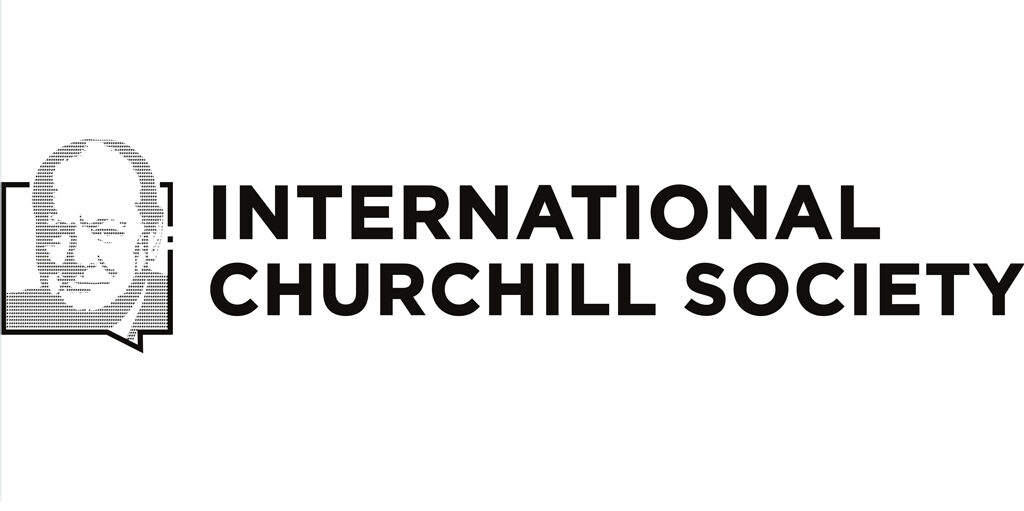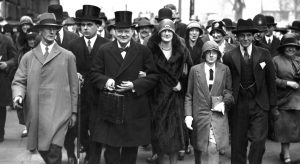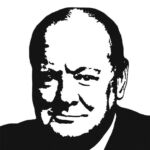
Reference
The Armorial Bearings of Sir Winston Churchill
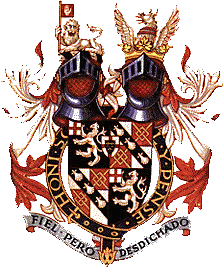
October 14, 2008
By Paul Courtenay
Mr. Courtenay is Hon. Secretary of ICS (UK); he is also a member of the (British) Heraldry Society.
Introduction
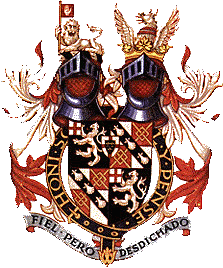 The Churchill coat-of-arms ought to be familiar enough to members. But how many understand what it is saying to us? In trying to answer this question, I cannot avoid giving an elementary Heraldry lesson; I should therefore apologise to those readers who already know a fair amount about the subject. Some of the terminology used is a little arcane so, rather than break up the narrative with frequent explanations, I have defined unfamiliar terms in a glossary at the end. By referring to this, and to the accompanying illustrations, it should be easy enough to follow the thread.
The Churchill coat-of-arms ought to be familiar enough to members. But how many understand what it is saying to us? In trying to answer this question, I cannot avoid giving an elementary Heraldry lesson; I should therefore apologise to those readers who already know a fair amount about the subject. Some of the terminology used is a little arcane so, rather than break up the narrative with frequent explanations, I have defined unfamiliar terms in a glossary at the end. By referring to this, and to the accompanying illustrations, it should be easy enough to follow the thread.
Heraldry as we know it today began to evolve in the second quarter of the twelfth century. The systematic use of devices, centered on the shield, became essentially hereditary in nature and allowed an individual – whose face might have been concealed by an armoured helmet – to be easily recognised. It was therefore important for each achievement of arms to be different from all others – at least in every generation. Thus a person’s arms are very much a personal possession which should not be used by anyone else during his lifetime. The kinship of relations to the head of a family can often be read from a shield, though it has to be admitted that the strict regulation of such matters is much more rigorously applied in Scotland than elsewhere in the United Kingdom. Marriage to women without surviving brothers (or the latters’ descendants) can allow further arms to be permanently added to those already in use. It has truthfully been said that Heraldry is the shorthand of history.

2025 International Churchill Conference
Component Parts of Armorial Bearings
Churchill Coat of ArmsArmorial bearings have several component parts. Those found in Sir Winston Churchill’s arms are:
Shield: The focal point of the armorial bearings (and the true coat-of-arms, although this term is often used today to refer to the whole achievement).
Helm: In this case there are two, and their configuration denotes the rank of the bearer. In this instance the visors are open and the helms are affronty (i.e. facing the observer); the helms are therefore those of a knight. Helms of royal persons, of peers and of others including corporate bodies, are each denoted differently.
Wreath: Just visible above the dexter helm, it is six visible twists of material in two tinctures, the purpose of which was to act as a setting from which the crest issued forth; it also allowed the mantling to be secured to the helm. In this case the wreath is Argent and Sable. [not as illustrated in FH102]
Crest: Again, in this case there are two (a Lion and a Griffin). A common error is to refer to the shield or to the whole achievement as a crest; this is quite wrong. Just as a crest of a hill or the crest of a wave is at the summit, so in Heraldry the crest is the device at the very top of the armorial bearings, and nothing else.
Mantling: This originated as a piece of material, hanging from the back of the helm and secured by the wreath, to protect the back of the neck from the sun’s heat. Today it survives as decorative strips framing the shield. Charles Lusted’s painting shows this as Sable and Argent, although – to be strictly accurate – it should in this case be shown thus on the dexter side only, and Gules and Argent on the sinister side. The jagged edges of the mantling are held by some authorities to depict the cuts and rents which would have been received in battle, but this is perhaps a little dubious.
Garter: This is borne only by Knights (and Ladies) of the Order of the Garter, to which Sir Winston was appointed in 1953, giving him a title for the first time. Its possession by Sir Winston provides a good example of how an achievement of arms can change from one generation to another; as neither his father nor his son was a Knight of the Order of the Garter, their arms‹otherwise identical, apart from the position of the helms (neither being a knight)‹would not have been able to feature this item. The famous motto of the Order – Honi Soit Qui Mal Y Pense – means Shame on Him Who Thinks Evil of It.
Motto: This is traditional, although not a formal part of the armorial bearings (except in Scotland).
The Churchill Arms
The original arms of the first Sir Winston Churchill (1620-1688), father of the First Duke of Marlborough, were extremely simple and were certainly in use by his own father in 1619. The shield was Sable a Lion rampant Argent debruised by a Bendlet Gules (figure 1). The addition of the Canton rendered this further distinguishing mark unnecessary. In recognition of the first Sir Winston’s services to King Charles I as Captain of the Horse, and his loyalty to King Charles II as a Member of Parliament. At the same time he was authorised to omit the Bendlet, which had served the purpose of distinguishing this branch of the Churchill family from others which bore an undifferenced Lion., he was awarded an augmentation of honour to his arms in 1661/1662. This rare mark of royal favour took the form of a canton of St. George. A canton is a square in the dexter chief, occupying less than a quarter (probably about one-eighth) of the shield, and in this case Argent a Cross Gules. At the same time he was authorised to omit the Bendlet, which had served the purpose of distinguishing this branch of the Churchill family from others which bore an undifferenced Lion.
This revised shield, complete with augmentation of honour, was inherited by his son John Churchill, First Duke of Marlborough (1650-1722). Note that the helm is in profile and has a closed grill; it therefore belongs to a peer. Extra features in these armorial bearings are:
Supporters: Peers, Knights of the Orders of the Garter and the Thistle and Knights Grand Cross of the other orders of chivalry are entitled to these figures, placed on either side of the shield to support it; they may be human, animal or mythical. In this case they were the mythical Griffin (part lion, part eagle) and Wyvern (a dragon without hind legs).
Coronet: Immediately above the shield is a coronet, indicating the bearer’s rank of duke.
Imperial Eagle and Princely Coronet: These unusual features show that the duke was a Prince of the Holy Roman Empire‹a dignity conferred in 1705.
The Churchill crest is blazoned as a Lion couchant guardant Argent, supporting with its dexter Forepaw a Banner Gules, charged with a dexter Hand appaumée of the first, Staff Or. (This crest, with the dexter Hand appaumée converted into a V-sign, forms the logo of the International Churchill Society and Finest Hour.)
The Churchill motto Fiel Pero Desdichado (Spanish for “Faithful but Unfortunate”) is also displayed.
The Spencer Arms
These are a little more complex. The shield of Hugh le Despencer in the fourteenth century was Quarterly Argent and Gules, in the second and third Quarters a Fret Or, over all a Bend Sable (see figure 3). There is some dispute as to whether the later Spencers were descended from him, but a good case can be made that they were‹through several female lines. By the time of Charles Spencer, 3rd Earl of Sunderland (1674-1722), the Bend Sable had acquired three Escallops Argent (see figure 4), partly to distinguish this branch of the family from other Spencers‹who bore, for example, five Mullets Argent or three Fleurs-de-Lys Or on the Bend Sable.
The Spencer crest was blazoned Out of a ducal Coronet Or, a Griffin’s Head between two Wings expanded Argent, gorged with a Collar gemel and armed Gules. (Just to confuse matters, a ducal coronet in a crest‹as shown here‹can be assigned to anyone, regardless of status, and should not be confused with a coronet of rank placed above the shield.)
The Spencer-Churchill Arms
Because the First Duke of Marlborough left no surviving son, the title was allowed to pass to his eldest daughter in 1722 and then (in 1733) to the son of his next daughter, who had married Charles Spencer, Third Earl of Sunderland. The Fifth Duke (1766-1840), who had been born a Spencer, was authorised in 1817 to take and use the additional name of Churchill, in order to perpetuate the name of his illustrious great-great-grandfather. At the same time he was empowered by Royal Licence to quarter the arms of Churchill with his paternal coat of Spencer. It is from this date that the familiar design of Churchill quartering Spencer originates. It would be normal in these circumstances for the paternal arms (Spencer) to take precedence over the maternal (Churchill), but because the Marlborough dukedom was senior to the Sunderland earldom, the procedure was reversed in this case.
In 1705, in recognition of his victory over the French and Bavarians at Blenheim the previous year, the First Duke had been granted the Manor of Woodstock, which was transferred to him from the Crown by Act of Parliament. Here was constructed the magnificent palace we know today. When the Fifth Duke’s arms were quartered in 1817, a further augmentation of honour was added to his achievement; this incorporated the bearings on the standard of the Manor of Woodstock and was borne on a shield, displayed over all in the centre chief point, as follows: Argent a Cross of St George surmounted by an Inescutcheon Azure, charged with three Fleurs-de-Lys Or. (This inescutcheon represents the royal arms of France.) These quartered arms, incorporating two augmentations of honour, have been the arms of all subsequent Dukes of Marlborough – together with both crests. Subsequently, the Seventh and Ninth Dukes, as Knights of the Order of the Garter, were able to encircle their arms with the Garter (as could the First, Third and Fourth Dukes of Marlborough before them.
The Rt Hon Sir Winston Churchill KG OM CH TD
Having traced the development of the Spencer-Churchill arms down to the recent holders of the Marlborough dukedom, what was Sir Winston Churchill’s entitlement? The principle is that a person’s arms should not be capable of confusion with anyone else’s. When displayed in full, as shown in Charles Lusted’s painting, they could not be confused with the armorial bearings of the contemporary Duke of Marlborough for two reasons. Firstly, no Duke of Marlborough was a Knight of the Order of the Garter at the same time as Sir Winston, so would not have been able to display its insignia as Sir Winston could do; secondly, the helms are those of a knight, whereas dukes show those of a peer. No confusion could therefore arise and, indeed, this is the form in which the arms are permanently shown on Sir Winston’s stall-plate in St George’s Chapel, Windsor (where the arms of all Knights of the Order of the Garter since the Order’s foundation in 1348 are displayed).
To avoid any possibility of confusion, a system of cadency marks can be used; by this system each son of a marriage shows a different mark on his father’s arms. Thus the eldest son bears a Label of three points Argent (i.e. a narrow horizontal strip across the top of the shield, with three short vertical pendants); he removes the Label on his father’s death, when he inherits his father’s undifferenced arms. The second son permanently shows a crescent and the third son a mullet (i.e. a five-pointed star).
Lord Randolph Churchill (1849-1895) was born the third son of the 7th Duke of Marlborough, so would in theory have borne the Spencer-Churchill arms differenced by a mullet. However, it is most improbable that he ever did so, because he was less than eighteen months old when his next oldest brother (the Seventh Duke’s second son) died. Lord Randolph therefore grew up as the Seventh Duke’s second surviving son and would have inherited his brother’s right to a crescent. Winston, as the eldest son of Lord Randolph, would‹in 1895 -correctly have inherited his father’s arms, i.e. Spencer-Churchill differenced by a crescent. Occasional representations of Sir Winston’s arms, showing a mullet, are sometimes seen in books, but these are quite wrong as his father’s hypothetical mullet was superseded by a crescent over twenty-four years before Winston’s birth.
On becoming a Knight of the Order of the Garter (KG) in 1953, Sir Winston would have been entitled to supporters to his arms, but these were never granted because he never got round to applying for them. There are grounds for believing that he was offered a further augmentation of honour to his armorial bearings in 1945, but that he declined because he felt that his arms were already somewhat crowded. Had this been awarded, the new arms would have passed to his son and grandson, but not to subsequent Dukes of Marlborough (who would not have been descended from him).
Had he wished, Sir Winston could have displayed the insignia of his other honours below his shield. These were the Order of Merit (OM), the Order of Companions of Honour (CH) and the Territorial Decoration (TD). (The prefix Right Honourable, for those who are mystified, is not a hereditary title in this instance, but indicates membership of the Privy Council – to which Winston Churchill was appointed in 1907; it has no heraldic implications.) Although never used in his lifetime, figure 6 shows the full armorial bearings of Sir Winston Churchill (with crescent, but omitting OM, CH, TD) as they could correctly have been displayed. Note the correct width of the Bend Sable in the Spencer quarterings, while Charles Lusted’s version‹to be mildly critical – is rather too narrow and more in the nature of a Bendlet. Note also the mantling, which is more traditional than Lusted’s.
I hope that readers who have followed the thread of this ramble through some heraldic byways will agree that Sir Winston Churchill’s armorial bearings exemplify the claim of Heraldry to be “the shorthand of history.”
Achievement (of Arms): The complete set of emblems, including shield, crest, supporters etc.
Affronty: Facing the observer.
Appaumée: Of a hand, showing the open palm.
Argent: Silver (more usually shown as white).
Armed: Refers to an animal’s weapons, including for example claws, beaks, horns etc.
Armorial Bearings: As for Achievement.
Arms: Coat-of-arms, i.e., strictly the shield, but it has come to mean the whole Achievement.
Azure: Blue.
Bend: A broad diagonal band from the dexter chief of a shield to the sinister base.
Bendlet About half the width of a Bend; a Bendlet sinister is from sinister chief
to dexter base.
Blazon: Heraldic terminology.
Canton: A square in the dexter chief of a shield, usually filling about one-eighth of it.
Centre Chief Point: The centre of the shield near the top.
Chief: The top part of the shield.
Coat-of-Arms: See Arms.
Couchant: A beast in the lying position, with head raised.
Cross of St George: Argent a Cross Gules.
Debruised: Refers to a charge overlaid by another charge.
Dexter: The right-hand side from the point of view of the bearer of the arms, so the left-hand side from the point of view of the observer.
Escallop: A scallop shell, usually its convex back.
First: Refers to the first tincture mentioned (thus, in the case quoted, Argent). This formula avoids the need for repetition.
Fleur-de-Lys: A stylised lily. Azure three Fleurs-de-Lys Or were the royal arms of France.
Fret: A Mascle interlaced by a Bendlet and a Bendlet sinister.
Garter (The Most Noble Order of the): The United Kingdom’s senior order of chivalry, founded by King Edward III in 1348.
Gemel: A pair.
Gorged: Collared.
Guardant: With the face looking out of the achievement towards the observer.
Griffin: A monster, with the hind parts of a lion and the head, breast, claws and wings of an eagle; it also has ears.
Gules: Red.
Inescutcheon: A shield borne as a charge on the main shield of the arms.
Label: A narrow horizontal strip across the top of the shield, usually with three short vertical pendents – normally Argent – which is displayed by an eldest son until his father’s death, when he removes the Label on inheriting the undifferenced arms.
Lozenge: A diamond-shaped charge.
Mascle: A voided Lozenge.
Mullet: A five-pointed star.
Or: Gold (more usually shown as yellow).
Quarter/Quartering/Quarterly: Relating to the division of a shield into four (or more) segments.
Rampant: Position of a beast, showing the sinister hind-leg on the ground, with all other legs pawing the air.
Sable: Black.
Sinister: The left-hand side from the point of view of the bearer of the arms, so the right-hand side from the point of view of the observer.
Tincture: All the metals (gold and silver), colours and furs used in Heraldry; so to refer to a “colour” has a strictly narrow meaning, excluding, e.g., yellow and white.
Voided: Refers to the centre of a charge being cut out, allowing another tincture to show through.
Wyvern: A monster with the appearance of a dragon, with a dragon’s tail but no hind-quarters or back legs.
Subscribe
WANT MORE?
Get the Churchill Bulletin delivered to your inbox once a month.
